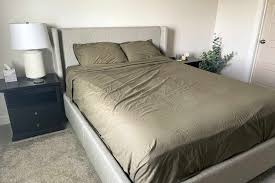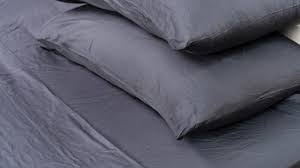In warm and humid places like Singapore, many people struggle with night sweats, disrupted sleep, and the constant tossing and turning from stuffy air and hot nights. I used to wonder why I felt tired despite spending a third of my life sleeping — until I started learning about how bed sheets are made. It turns out, the material of your bed sheets can directly affect your temperature and sleep quality. In such a climate, breathable fabrics like cotton percale or bamboo really help you stay cool, giving your body the rest it needs to refresh, repair your immune system, and let your brain fully recover. Once I made the switch, I finally experienced quality sleep, feeling productive, healthy, and truly awake each morning after a proper good night’s rest.
How Temperature Affects Sleep
Last summer, I realized just how much temperature can change the way we sleep. Living in a tropical environment, I often found myself sleeping hot and waking up drenched in sweat. According to a study in the International Journal of Environmental Research and Public Health, hotter temperatures lead to disrupted sleep, and it makes complete sense. When bedroom temperatures rise, the body clock or circadian rhythm, which regulates our wake times and when we fall asleep, gets thrown off. This natural rhythm is also affected by exposure to light, physical activity, and our surroundings. If you are too hot, it becomes harder to fall into deep REM sleep, which can negatively impact memory, learning abilities, and even weaken immune systems.

In my case, every time I struggled to fall asleep, I felt less alert the next day and more anxious. That is likely because poor sleep quality increases stress hormones like cortisol, making it more difficult to relax and get back to sleep. A cooler room brought more ease, and helped me drift off faster with better sleep satisfaction and sleep calmness. Since making these changes, I’ve noticed a sharp decrease in waking up during the night, and an improvement in my overall rest. The environment around us, especially higher night-time temperatures, affects not just how long we sleep, but also how well we rest.
What Is The Ideal Temperature For Sleep?
Living in Singapore, where summer months feel endless, I struggled to find the perfect balance for sleep until I read that the National Sleep Foundation suggests the ideal sleeping temperature falls between 18°C and 26°C. But in a climate like ours, relying on air conditioning every night can be costly and harmful to the environment, especially with the frequent use it demands. The downside is not just the cost or potential damage, but how natural air ventilation is often overlooked as a solution. When the room is too warm or cold, it can negatively impact sleep quality, so creating an optimum temperature range using a fan, breathable bedding, or smart AC use works best for different people depending on their comfort level. Personally, I’ve found that setting the AC to 24°C with a timer creates just the right cool zone for restful sleep without overusing energy.
The Cost-Effective Alternative: Bed sheets That Stay Cool
After relying heavily on my air conditioner for years, I started looking for a smarter alternative to cool down my room without hurting my wallet or the planet. That is when I discovered cooling bed sheets — a simple yet powerful investment. Paired with a fan and open windows in well-ventilated bedrooms, these cooling bed linen options helped me manage my sleeping temperature better, even when air conditioning was reduced or completely removed. What’s more, many of these are eco friendly, and I even started wondering, are bed sheets recyclable after long use? In the long run, these sheets not only improved my sleep quality but also helped me stay comfortable without running up my electricity bill. Now, my nights are cooler, my room feels fresher, and I have more control over how I manage the temperature naturally.

What Properties Make A Cooling Bed Sheet?
The type of material, weave type, and thread count are key factors that determine how cool your sheets feel at night. Good cooling sheets have strong breathability and moisture absorbency, keeping you dry and comfortable. I always choose light fabrics with a crisp weave to stay sweat-free.
1. Stay Dry All Night with Smart Fabric
A sheet’s moisture-wicking abilities are a key factor that can determine how fresh and dry you feel during sleep, especially if you deal with night sweats. This property helps remove excess moisture and lower your body temperature, making temperature-regulating sheets a smart choice for hot nights.
2. Let Your Skin Breathe at Night
Breathable fabric is the secret behind cool wicking sheets that help manage moisture and keep bodies dry. When sheets have poor moisture absorbency or are less breathable, they trap heat and make sweating worse, which can induce night sweats. I’ve found that using fabrics that naturally regulate temperature makes it much easier to sleep without feeling sticky or hard to rest.
3. How the Weave Changes the Feel
The weave method of your sheets makes a big difference in how cooling they are and how they feel on skin contact. For instance, percale cotton sheets feel crisp and breathable, while sateen has a smoother appearance and skin feel but may trap more heat.
4. Why Thread Count Matters for Cool Sheets
Thread count plays a key role in how cool your sheets feel, but not always in the way you think. The National Sleep Foundation recommends bed sheets between 200 and 400, as higher thread count can trap heat, especially when manufacturers bump up numbers using multi-ply or lower quality threads, making it a poor determining factor for good quality if the cotton type is weak.
5. Bed Sheet Material
The base material of your sheets is one of the most important factors when it comes to staying cool. A quick breakdown of the top cooling sheet fabrics shows that cotton, bamboo, and TENCEL™ (made from eucalyptus fibres) are the most popular choices for their breathable properties and ability to help you sleep cool, depending on your preferences and the type you choose.
Best Cooling Bed Sheet Material Comparison
1. Why Cotton Still Rules for Cool Sleep
When comparing the best materials for cool sleep, cotton remains a classic choice for both clothing and bed linen due to its naturally breathable and cooling properties. High good quality cotton fabric, especially Egyptian cotton, offers soft sheets with excellent cooling abilities, thanks to fine cotton fibres and smart weave method. For instance, percale sheets have a crispier feel and are lightweight and breathable, while cotton sateen sheets are heavier, with a complex weave structure that gives them a quieter, silkier texture, but slightly less cooling.
However, while cotton offers great comfort, it is considered one of the least eco-friendly options due to its cultivation method and impact on ecosystem damage. If you’re looking for more sustainable alternatives with similar cooling effects, materials like bamboo might be better for the environment. Still, for many, the feel of a high-quality cotton sheet, whether percale or sateen, remains unmatched.
2. Why Bamboo Sheets Are a Cool and Smart Choice
Bamboo sheets are quickly becoming a favorite for cooling sheets due to their desirable qualities like being more breathable, softer, and more flexible than cotton. Made from natural bamboo fibres, they have antibacterial and antifungal benefits, and studies show the fibre’s performance in warmer temperatures helps reduce heat trapped around the body by offering the lowest thermal resistance among three materials tested. This means bamboo can lower your core body temperature better than traditional cotton. Though some treatment processes may involve sulfuric acid or carbon disulfide, many brands now offer eco-friendly options that limit harm. Bamboo is also less prone to wrinkles, pilling, and shrinkage, making it both practical and luxurious.
3. Why Sheets Are a Smart Cooling Choice
Sheets, made from eucalyptus, are part of Our Collection and are known as the coolest fibre type of the latest generation of cooling bed sheets. Their Lyocell fibres are 100% natural fibres that absorb and release excess moisture, helping to regulate temperature and keep hot sleepers sweat-free. A study shows their temperature-regulating properties, moisture management, and comfort properties make them ideal for a comfortable, cooling sleep. Their structure gives a silky smooth, soft feel, making them gentle on sensitive skin, and they reduce bacterial growth by 10 times compared to cotton or bamboo rayon in unsuitable conditions. Plus, with higher tear resistance, Lyocell fabrics are both durable and eco-friendly, thanks to sustainably harvested resources and clean production processes, making them a smart long-term investment for anyone who values environmentally friendly comfort.
FAQS
Which Bed Sheet Material Feels the Coolest?
Breathable sheets made from natural materials like cotton and linen are best for staying cool and dry during sleep. Their fiber content, loose weave, and increased air movement boost ventilation, which is crucial in determining the cooling ability of your sheets.
What is the best bedding for a cool sleep?
Bedding sets made from natural fibres like bamboo or wool are a great choice because they are naturally breathable and have strong moisture wicking properties. Look for temperature-regulating duvets and pillows with a low tog rating if you tend to sleep hot, and avoid heavy covers when you buy.
What type of sheet material is best for hot sleepers?
Cotton percale, linen, and bamboo are great choices for hot sleepers because they are light, crisp, and allow excellent airflow. These fabrics feel soft, help regulates temperature, and work well even in humid conditions, helping you stay cool and comfortable all night.

